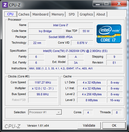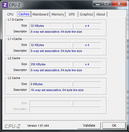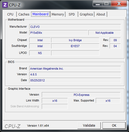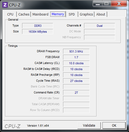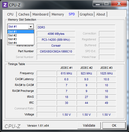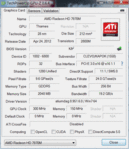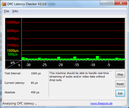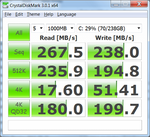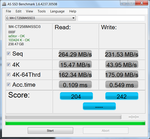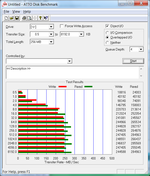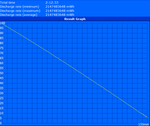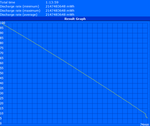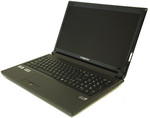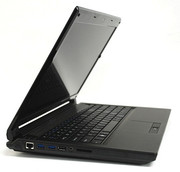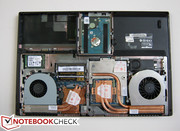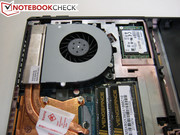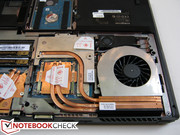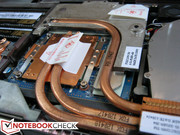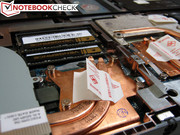Review Update Eurocom Racer 2.0 (Clevo P150EM barebones) Notebook

With Ultrabooks on the rise, more and more manufacturers are shifting gears to create ultrathin notebooks with emphasis on sleek appearance before solid specs and performance. On the other end of the spectrum, Eurocom caters to power users on the move and continues to focus on both ultra high-end DTRs and mobile workstations. More recently, the Canadian company launched its 11.6-inch Monster 1.0 gaming notebook (based on the Clevo W110ER barebones) to compete against the similarly-sized Alienware M11x series and the massive 17.3-inch Scorpius DTR.
This review will take a closer look at the Racer 2.0, a 15.6-inch gaming notebook based on the Clevo P150EM barebones. As such, more pictures and our rundown on the chassis, connectivity, overall responsiveness and ease of accessibility can be read in our full review of the P150EM. Our review on the original Racer 1.0 with a Core i7-2720QM and AMD HD 6970M can be seen here.
This leaves us to focus on the performance side of the Racer 2.0, namely its quad-core Core i7-3920XM and the freshly released Radeon HD 7970M. With hardware this powerful, only a few notebooks, such as the similarly specced 17.3-inch Alienware M17x R4, can compete in raw numbers. Our Eurocom unit has been configured to about $3300 retail, but how does the top-tier Pitcairn Radeon compare against the competition?
Display
The Eurocom on hand is equipped with a high quality 1080p Lenovo display instead of an LG as did our P150EM barebones unit. Overall brightness has been reduced by over 100 nits compared to the LG display, but the gains in reproducible colors are substantial and may be well worth the brightness drop. The color space trumps both the Alienware M17x R4 and P150EM and is on par with (if not better than) many high-end mobile workstations such as those from HP or Dell. In other words, the Racer 2.0 may satisfy digital graphic artists who can also take advantage of the powerful specs. Even subjectively the colors appear deeper and more saturated than most notebooks.
| |||||||||||||||||||||||||
Brightness Distribution: 88 %
Center on Battery: 252 cd/m²
Contrast: 813:1 (Black: 0.31 cd/m²)
87.7% AdobeRGB 1998 (Argyll 3D)
95.8% sRGB (Argyll 3D)
79.8% Display P3 (Argyll 3D)
Outdoor use is possible due to the matte display and sufficient brightness. Although the maximum brightness is nowhere near that of the W150ER LG display, it is still well above 200 nits (even when running off battery) and we found no major issues with glare or reflections unlike with the M17x R4. We do, however, recommend avoiding direct sunlight and setting the brightness to its highest for better visibility.
Viewing angles are equally impressive and stable. Despite being a TN panel, the colors are subjectively sharp and do not shift by noticeable amounts when viewing horizontally. Colors still shift if viewing vertically above or below the center normal, but the acceptable angles are much wider than most typical notebooks. Traditionally, TN panels have had faster response times than IPS panels – an important factor for quick-moving games.
Performance
The real star of the Racer 2.0 is what’s inside the hardware. At its heart lies a quad-core i7-3920XM, essentially one of the fastest mobile Ivy Bridge processors currently available. When idle and in Energy Saver mode, each core hovers around the 1.2 GHz mark, but High Performance mode will immediately bump the speed to twice that at a base 2.4 GHz. Turbo Boost is supported for a theoretical maximum of 3.8 GHz, 3.7 GHz and 3.6 GHz for one, two, and four active cores, respectively. The processor is largely similar to the previous generation Sandy Bridge i7-2960XM as both CPUs share the same cache sizes and TDP, although the Ivy Bridge model is manufactured in a smaller die size for improved performance-per-watt. See here for more information and benchmarks on the Core i7-3920XM.
Memory is provided by four 4 GB 1866 MHz DDR3 modules from Corsair for a total of 16 GB, according to CPU-Z. Two SODIMM slots are easily accessible from the underside by removing a small set of Philips screws.
We experienced no recurring high latency peaks with the DPC Latency Checker even with wireless radios active.
Processor
In the synthetic CPU-oriented benchmarks, the i7-3920XM competes well against other high-end offerings like the 2.7 GHz i7-3820QM and even the desktop 3.5 GHz i7-2700K in CineBench CPU rendering results. For example, all three score very similarly with about 6.8 to 7 points in CineBench R11.5 Multi 64-Bit and about 19500 points in CineBench R10 Multi 32-Bit. Meanwhile, wPrime and SuperPi calculations can be completed in literally just a few seconds faster than the previous Sandy Bridge record holder, the i7-2960XM. The data automatically places the Racer 2.0 against hard hitters like the Asus G75V (i7-3720QM, GTX 670M), Alienware M18X R2 (i7-3920XM, HD 7970M) and even workstations like the ThinkPad W530 (i7-3820QM, Quadro K2000M) and HP EliteBook 8560w (i7-3820QM, GTX 680M).
System Performance
We evaluate system performance with the usual PCMark 7 and Vantage benchmarking tools. These Futuremark programs are heavily skewed towards systems with SSDs - And rightly so, as a solid-state drive is one of the best ways to boost system responsiveness and performance. With PCMark 7 and Vantage scores reaching almost 5000 and 20000 points, respectively, the Racer 2.0 sits amongst performance kings such as the Schenker XMG and is only a couple thousand points away in Vantage from our top performer in our database: the Alienware M18x R2 with HD 7970M CrossFire.
The more striking fact is that the Racer 2.0 can achieve these scores with a mSATA drive and a traditional HDD; The notebook should be able to to break into higher benchmarking numbers if outfitted with a dedicated full-speed 2.5-inch SATA III SSD.
Subjectively, everyday tasks seem snappy and almost instant. If we didn't know any better, we would have assumed that the system was running only on a solid-state drive.
| PCMark Vantage Result | 19086 points | |
| PCMark 7 Score | 4949 points | |
Help | ||
Mass storage
Similar to many Ultrabook releases, the Racer 2.0 can be equipped with both a 2.5-inch HDD and a mSATA SSD for a hybrid storage solution. Unlike these same Ultrabooks, however, the SSD is a fully accessible physical drive in Windows and is not used merely for caching purposes. In our case, it is also where Windows 7 is installed. Users can freely move files amongst the two physical drives as they would normally between any two drive letters.
Our particular review model includes a fast 750GB Seagate Momentus XT HDD and a 256GB Crucial M4 SSD, both of which utilize SATA III connectivity. The 7200 RPM drive averages 92.5 MB/s in transfer rate according to HD Tune – faster than many competing 7200 RPM drives – but still no match against the >100 MB/s speeds of the fastest notebook HDDs. For our growing list of HDD benchmarks, see here.
More impressive than the HDD is the faster-than-expected SSD. In benchmarks such as AS SSD and ATTO, the Crucial drive returns Write scores (notably the 4k-64QD scores) considerably faster than the SATA II mSATA in the Alienware M17x R4 and most other mSATA drives we’ve tested so far for that matter. Sequential write speeds are still behind 2.5-inch SATA III SSDs like the Intel 510 Series or the OCZ Vertex 3, but sequential read speeds are not trailing very far from these same drives. Given the size and relatively low market penetration of mSATA, the performance of the Crucial drive in the Racer 2.0 is quite the high note.
| 3DMark 03 Standard | 46082 points | |
| 3DMark 05 Standard | 28102 points | |
| 3DMark 06 Standard Score | 22142 points | |
| 3DMark Vantage P Result | 22404 points | |
| 3DMark 11 Performance | 5980 points | |
Help | ||
Gaming Performance
At its best, the HD 7970M trades blows with the GTX 680M while costing hundreds of dollars less. The Alienware M17x R4 is a prime example of the Radeon card flexing its muscle to its fullest. However, we cannot say the same about the HD 7970M in the Racer 2.0 as its performance is rather unreliable.
Gaming results are mixed on the reviewed unit, and we believe that the graphics switching technology Enduro could be the culprit. We benchmarked the games below with out-of-the-box drivers (GPU: 8.951.6.0, Catalyst: 0329.2312.39738). Only two of the eight tested games (Arkham City and Battlefield 3) were immediately recognized by Enduro and played without any issues at all. We detail the problematic titles below:
Metro 2033
Starcraft 2
The two year old Blizzard RTS could run on high settings just fine from mid-range graphics cards, but we were unable to launch the game correctly with the HD 7970M. Even after manually setting the title to "High Performance" in Enduro, we suspect that the game refuses to play on the dGPU. This could be due to the recent 1.5.1 Battle.net patch or could be from a driver issue, but this oversight is downright unacceptable either way. Frame rates hover around 30 FPS, even on Medium settings and 720p resolution.
Deus Ex: Human Revolution
F1 2011
F1 2011 was recognized by Enduro on first launch, but performance is shameful for such a high-end GPU. While the game can run above 60 FPS on the M17x R4 at maximum settings, the Racer 2.0 only averages about 40 FPS on the same in-game benchmark. The game also crashed without warning during one benchmarking session and had to be restarted.
Modern Warfare 3 and Skyrim
These two titles were not recognized by Enduro on first launch, but both will play without issues once the dGPU has been assigned. Skyrim in particular had odd graphical glitches when running only on the preset Medium settings.
| low | med. | high | ultra | |
|---|---|---|---|---|
| Metro 2033 (2010) | 141 | 94 | 29 | |
| StarCraft 2 (2010) | 33 | 24 | 12 | |
| Deus Ex Human Revolution (2011) | 153.7 | 81.6 | ||
| F1 2011 (2011) | 49 | 41 | ||
| Batman: Arkham City (2011) | 84 | 57 | ||
| Battlefield 3 (2011) | 75 | 63 | 38 | |
| CoD: Modern Warfare 3 (2011) | 109 | 87 | ||
| The Elder Scrolls V: Skyrim (2011) | 96.8 | 58 |
Emissions
System Noise
It shouldn’t be a surprise to anyone that the dual system fans in the Racer 2.0 are going to be audible no matter the current activity. When the system is idle and on the Power Saver profile, fan noise is acceptably low at a recorded 34.3 dB(A). Unfortunately, fan speed will consistently (and noticeably) rev up for a few seconds multiple times a minute up to 37.7 dB(A), even when the system is left alone. This leads to uneven fan noise during daily use, which isn't a significant issue but can be a bit discording to some users and during video playback. We should note, however, that the similarly equipped Alienware m17x R4 is on average distinctly quieter, albeit this may be attributed to its larger overall size.
When stressed or gaming, noise levels from the fans can increase to almost 50 dB(A). This is comparable to most DTR gaming rigs, but is a bit louder than the original Racer. The noise is generally tolerable while gaming, but can be unpleasant during quieter gameplay moments. Fortunately, such high sound levels do not occur during 1080p video playback.
Noise level
| Idle |
| 34.3 / 34.4 / 37.7 dB(A) |
| DVD |
| 38.4 / 48.8 dB(A) |
| Load |
| 49.2 / 49.5 dB(A) |
 | ||
30 dB silent 40 dB(A) audible 50 dB(A) loud |
||
min: | ||
Temperature
Idling surface temperatures are quite cool given the powerful hardware at about 31 to 32 degrees C for both the bottom and upper surfaces of the base. The hottest areas are located on the bottom nearest the front and directly underneath the HDD and CPU. With idle temperatures upwards of 37 degrees C on these particular spots, the DTR is best used on a desk as expected. Thankfully, the keys and hand rest surfaces are comparatively cooler and do not make typing uncomfortable. The same Clevo barebones with a GTX 675M, however, runs generally cooler than this model equipped with an HD 7970M.
When under maximum load, average temperatures on both sides can rise by a few degrees on average, but three spots in particular can become uncomfortably hot at well above 40 degrees C each. These areas are directly over the HDD and the two respective corners close to the CPU and GPU. The keyboard surface can reach 40 degrees C as well, which isn’t too uncomfortable, but can lead to sweaty palms during prolong play of extra-demanding 3D games.
(-) The maximum temperature on the upper side is 46 °C / 115 F, compared to the average of 40.4 °C / 105 F, ranging from 21.2 to 68.8 °C for the class Gaming.
(±) The bottom heats up to a maximum of 42.2 °C / 108 F, compared to the average of 43.3 °C / 110 F
(±) In idle usage, the average temperature for the upper side is 32 °C / 90 F, compared to the device average of 33.9 °C / 93 F.
(+) The palmrests and touchpad are cooler than skin temperature with a maximum of 30.8 °C / 87.4 F and are therefore cool to the touch.
(±) The average temperature of the palmrest area of similar devices was 28.9 °C / 84 F (-1.9 °C / -3.4 F).
We performed our usual methods to test for throttling by employing Prime95 and FurMark to stress the CPU and GPU, respectively. Unfortunately, none of the tested GPU monitoring tools (HWiNFO, GPU-Z, GPU Shark) were able to correctly display any real-time information on the dGPU and this stress test may be repeated at a later date when more support becomes available.
In the CPU-only stress, Prime95 was left to run continuously while CPU speeds were monitored with HWiNFO and CPU-Z. All four cores were operating at 3200 MHz, but steadily dropped and settled at 2900 MHz each after a few minutes. We noticed this occurring each time a core reached an internal temperature of about 98 degree C as the 2900 MHz speed flattens the core temperature closer to a safer 90 to 91 Degrees C. Not once, however, did we witness any core operating above 3200 MHz during this particular test.
Without a proper GPU monitoring tool, assessing the GPU stress test is rather moot. HWiNFO shows the GPU temperature stabilizing at about 47 degrees C with each CPU core running at full 3500 – 3600 MHz speeds throughout the test. Similarly, the CPU cores were again able to maintain 2900 MHz under full system stress (Prime95 + FurMark). Otherwise, we can only assume for now that the GPU is running smoothly at its advertised 850/1200 MHz core/memory clock rates.
Battery Life
The power-hungry Racer 2.0 is driven by an 8-cell 76.96 WHr removable Li-ion battery capable of up to 5200 mAh. These are the exact same specs as the battery unit found on the original Racer, but the improvements of the Ivy Bridge architecture should provide the same if not longer battery lives than did our first Racer review unit. We ran the same tests and conditions on BatteryEater to compare.
At the lowest brightness setting and the Power Saver profile, we ran the Reader’s Test until the notebook automatically shut itself off after just 2 hours and 13 minutes.
On the opposite end of the scale, we set the notebook to the highest brightness setting and on the Performance profile with the Classic Test. The notebook gave in after 1 hour and 14 minutes.
A WLAN test with a looping script to simulate typical browsing conditions only faired a few minutes below that of the maximum battery life. In other words, battery runtime is almost identical to the original Racer while having improved performance from the updated processor and graphics card. The similarly equipped Alienware is able to last much longer in general, but it includes a larger 90WHr battery and an option to switch off Enduro completely for better runtimes.
It’s worth noting that the CPU in the Eurocom maxes out at 2000 MHz per core when running on batteries. This may have been implemented to artificially increase battery life, so we recommend working close to an outlet (as with all DTRs) in order to attain the full performance potential from the system.
Verdict
The Eurocom Racer 2.0 is, overall, an impressive 15.6-inch DTR in terms of hardware. The display is one of the more remarkable TN-based panels out there and the CPU marginally outscores the previous i7-2960XM champion in synthetic benchmarks. When powered from an outlet, the system experiences no major throttling issues despite the heavy load and power under the hood. In short, the notebook can definitely hold its own.
The bane of the Racer 2.0 doesn’t lie in the hardware, but in the software. In particular, AMD’s Enduro is more of a hassle than a solution. At its current state, the technology does an appalling job at recognizing programs and choosing between the iGPU or dGPU. Even after assigning a program to the dGPU, the system or software gives no concrete indication as to which GPU is currently active. The software has also been proven to shave off frame rates for some games, which may make users feel cheated on that last ounce of juice from the HD 7970M. We have said before that we wish Clevo could implement a feature to disable Enduro completely similar to the Alienware M17x R4, but alas, our demand continues to be wishful thinking.
The software issues are not the fault of Eurocom, of course, who have done a terrific job on assembling the Racer 2.0. Our fingers point to AMD, whose slow driver support for the HD 7970M can feel underdeveloped and whose Enduro software at the time of review is bottlenecking an otherwise super-powerful Radeon GPU and a great successor to the original Racer. The only hope now is for AMD to provide the necessary official drivers and bug fixes for their loyal Radeon fans in a timely manner. Until then, the full potential of the HD 7970M in the Racer 2.0 can feel somewhat locked.
The notebook is still worth a look for enthusiasts and we recommend checking out the vast configuration options that Eurocom offers. Until the Enduro issues are sorted out, however, buyers may be better off with the GeForce GTX 680M or GTX 670M option for more reliable gaming performance.
In Comparison
| StarCraft 2 - 1920x1080 ultra (sort by value) | |
| Eurocom Racer 2.0 | |
| Schenker XMG P702 PRO | |
| Schenker XMG P702 PRO | |
| MSI GT70PH-i7169BWW7H | |
| Alienware M17x R4 | |
| Battlefield 3 - 1920x1080 ultra AA:4x MS AF:16x (sort by value) | |
| Eurocom Racer 2.0 | |
| Schenker XMG P702 PRO | |
| Schenker XMG P702 PRO | |
| MSI GT70PH-i7169BWW7H | |
| Alienware M17x R4 | |
| F1 2011 - 1920x1080 Ultra Preset DX11 AA:4xMS (sort by value) | |
| Eurocom Racer 2.0 | |
| Schenker XMG P702 PRO | |
| MSI GT70PH-i7169BWW7H | |
| Alienware M17x R4 | |
| Metro 2033 - 1920x1080 Very High DX11 AA:A AF:4x (sort by value) | |
| Eurocom Racer 2.0 | |
| Schenker XMG P702 PRO | |
| Schenker XMG P702 PRO | |
| MSI GT70PH-i7169BWW7H | |
| Alienware M17x R4 | |
| Batman: Arkham City - 1920x1080 Extreme Preset DX11 AA:4x MS (sort by value) | |
| Eurocom Racer 2.0 | |
| Schenker XMG P702 PRO | |
| Schenker XMG P702 PRO | |
| MSI GT70PH-i7169BWW7H | |
| Alienware M17x R4 | |
| CoD: Modern Warfare 3 - 1920x1080 Extra, all on, Image Quality: Native AA:4x (sort by value) | |
| Eurocom Racer 2.0 | |
| Schenker XMG P702 PRO | |
| Schenker XMG P702 PRO | |
| MSI GT70PH-i7169BWW7H | |
| Alienware M17x R4 | |
| The Elder Scrolls V: Skyrim - 1920x1080 Ultra Preset AA:8x AF:16x (sort by value) | |
| Eurocom Racer 2.0 | |
| Schenker XMG P702 PRO | |
| Schenker XMG P702 PRO | |
| MSI GT70PH-i7169BWW7H | |
| Alienware M17x R4 | |










